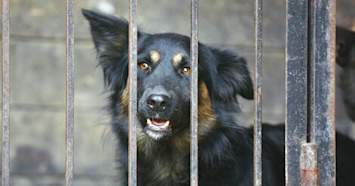
October and November are with dog-centered holidays. October 1st is “National Black Dog Day” and October 28 is National Pit Bull Awareness Day. In fact, the month of October is generally considered to be Adopt a Shelter Dog Month and November is Senior Pet Month.
The sad truth is that there are some traits that make it harder for shelters and rescues to place dogs. Sometimes it has nothing to do with temperament, history, or even their personality: it has to do with appearance. So, what type of dogs are deemed “less adoptable?” And on the contrary, what are the best dog breeds to adopt for first time owners?
Black Dog Syndrome
Most experienced shelter workers will tell you that black dogs are often adopted less than any other coat color. Be it black Labrador Retrievers, Shepherds, Rottweilers, etc., they are often passed over by potential adopters. This discrepancy in adoptions is referred to as “Black Dog Syndrome.”
Some theorize that black dogs are not adopted due to their color not being photogenic, or daunting indistinct facial features due to kennel lighting. They are viewed as common and, though disheartening, many media portrayals of black dogs are negative and create an unwanted stigma.
However, a dog’s coat in no way reflects their temperament, affection, or how they will fit into your home.
Upside to Black Dogs:
Black fur is far easier to combat than white, so it hides on clothes far better. Wardrobe win!
Big Dogs
That brings us to the “big”-dog factor. There’s a stigma to large breeds like the Rottweilers and German Shepherds. People even avoid walking by big mutts. While smaller dog breeds are typically scooped up from rescues quickly, larger breeds such as Retrievers and Mastiffs are left behind all too commonly. Many people believe that bigger breeds mean bigger vet payments and more food – but they also mean more love!
Upside to Big Dogs:
Most large breeds are considered to be “calmer” than small breeds. Your average Rottweiler or Retriever is more likely to be a couch potato, needing fewer walks and even fewer potty breaks. Despite the old line of thinking that small dogs are easier, big dogs are often more compatible with apartment living and busy lifestyles.
Senior Dogs
The senior dog factor is perhaps the biggest strike against a dog’s likelihood of adoption. Litters of puppies fly out of the shelter cuddled in adopters’ arms, while people pity the senior dogs on their way out the door. The risk of health issues is a concern to some, but the bigger issue lies in the fact that senior dogs are more likely to be depressed in the shelter.
They are possibly missing their old owners or fellow pets, and their personalities are a bit subdued as a result. Their personalities just don’t shine through in the shelter system. Many shelters even have reduced pricing for adult or senior pets and increased adoption fees for youngsters - that’s how difficult it is to get these older pups adopted. Most older dogs are in simply in need of a comfortable couch and human to love them.
Upside to Seniors:
Talk about calm! Most senior dogs are grateful for a few belly rubs a day and need less exercise. And, as one adopter of a 12-year-old Belgian Malinois said, “They’re a shorter commitment.” He wanted a dog at home while his kids were coming and going from college, but knew he wasn’t undertaking a 20-year relationship.
Pit Bull Breeds
An article from Bark Post states, “Each year, 1.2 million dogs are euthanized, approximately 40% of whom are Pit Bulls. This means that nearly half a million Pit Bull-type dogs are killed in shelters annually. Of all the common dog types to appear in shelters, Pit Bulls are by far the most likely to be euthanized, while they’re only the third most likely to be adopted”.
Unfortunately, many dogs with “Pit Bull” appearances are immediately written off as aggressive. This is not the case. In the early 1900s, pit bull breeds were referred to as “nanny dogs” due to their gentle, calm dispositions around children.
Upside to Pit Bull Adoption:
You’ll get more smooches than any other dog owner on your block! Don’t believe the myths - Pit Bulls and other blocky-headed dogs can make loyal companions.
Disabled Dogs
Disabled, or as we like to call them “specially-abled,” dogs are commonly forgotten in shelters and rescues. They are viewed as high maintenance or high cost risks. Depending on the dog, this couldn’t be farther from the truth. Some disabilities that are looked down on are:
The list goes on but the lack of adoption cannot. Most blind or deaf dogs can be trained by hand signals or sounds in order to compensate for their lost sense. Amputees can get around like any other dog, as well. Half the time you can pass a dog missing a leg and never notice their different gait! As for pups that need specific, daily medication, it becomes a small part of your daily routine. And in exchange for all this “extra work” you get an unwavering best friend.
Upside to Disabled Dogs:
They love their humans! You both can rely on each other for anything. Plus, it is a great conversation starter and way to make people aware of dog-disabilities in public.
Next time you’re looking for your new best friend, take a second look at the dog you might have passed over. It could be life saving for them and life changing for you.